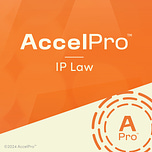Listen on Apple Podcasts, Spotify and YouTube.
Welcome to AccelPro IP Law, where we provide expert interviews and coaching to accelerate your professional development. Today we’re featuring a conversation with Coke Morgan Stewart, Senior Counsel at O’Melveny.
Stewart is a seasoned intellectual property and appellate litigator with decades of experience in private practice and government service. She served as the second highest-ranking officer of the United States Patent & Trademark Office, and as Deputy Attorney General for the Commonwealth of Virginia.
We talk about writing successful patent appeal briefs, pointers for improving brief writing, the patent appeal process and more.
“You want to win on the first page, as the saying goes. But you really just want to orient the judges to your case, and make them a little bit interested in what you're going to say,” Stewart tells us. “I think of the introduction, or the brief, as a movie. The introduction is a trailer to the movie that the court is about to see. Definitely don't overlook that opportunity.”
Listen on Apple Podcasts, Spotify and YouTube.
Interview References:
Coke Stewart’s O’Melveny profile.
2:45 | Administrative Procedure Act (APA), 5 U.S.C. §§ 551–559 (1946).
2:46 | Patent Trial and Appeal Board. United States Patent and Trademark Office (USPTO).
6:41 | Leahy–Smith America Invents Act (AIA), Public Law 112–29 (2011).
TRANSCRIPT
I. SUCCESSFUL PATENT APPEAL BRIEFS
Neal Ungerleider, Host: What differentiates a successful patent appeal brief from an average one?
Coke Stewart: As attorneys, I think we are properly focused on identifying errors on appeal.
But where we're lacking is on how we're communicating those errors.
I was looking at some statistics from the Court.
As of March of this year, the Court had, and this is kind of unbelievable, over 1600 cases pending. About a thousand of those cases are patent cases, and you only have 12 active judges.
You have a handful of senior judges that have a reduced docket. We have to be thinking, “How are you gonna make your points clearly and concisely? How many issues are you gonna be identifying for the Court, and how are you going to organize your brief?”
My advice would be to keep your brief as simple as possible. Try to identify no more than three issues for review, and make sure you're organizing your writing by starting with the rule applicable to that issue.
We all learn that in law school. It's really easy to forget when we're writing, and we're talking about all the things that happened below.
What are you really asking for?
If possible, every section of your brief should begin with the rule that you claim is violated.
Something that comes up a lot for me is, you might say, “Under the APA, the Patent Trial and Appeal Board has to consider all relevant evidence, and that didn't happen here.”
Something really simple like that is a really good way to begin one of your major argument sections.
NU: What specific approaches have you found are especially useful for engaging with judges during oral arguments and patent cases?
CS: It depends somewhat on whether you're appellate or appellee.
One way to think about it is that oral arguments are really about affirming the by decision.
By that, at least at the Federal Circuit, the judges are completely immersed in the case by the time the argument occurs. They're incredibly well prepared.
Honestly, they've probably already decided how they think the appeal should come out.
As many of us are aware, in a lot of cases, summary affirmances are actually issued the next day after an argument.
What you want to do is understand what the purpose of the argument is. It's usually about resolving a few lingering issues that the judges have, so they can close the case and move on to their next case.
It is not about presenting an overview of your entire case.
You have to be prepared on maybe a hundred points, but you have to understand that the judges may only want to talk about two or three of those points. Now, if you feel like the judges are leaning against your position, you have to have a different approach.
That's really grounding your argument and binding legal precedent.
In other words, let's say your case isn't very sympathetic. Why does the court have to decide in your favor?
You have to stay very grounded in the record and the relevant statutes, regulations and case law. You can convince them, even if they don't want to decide in your favor, that they have to.
I guess the last thing I would say, and I see this all the time (even though it's common sense), don't argue with the judges.
Don't evade their questions. You're really just there to answer their questions. You're not there to make a presentation. You've already presented your case in the brief. You're just there to answer whatever lingering questions they still have.
NU: Can you tell us a little bit about how to preserve issues and evidence for appeal for the Federal Circuit?
CS: With very rare exceptions, you can only make arguments and cite evidence on appeal that you made below.
The first thing I do when I get an appeal is I print out the entire record. Sometimes it just fills up my entire desk, and I start flagging and highlighting evidence and arguments that I want to bring to the court's attention.
I'm really grounded by whatever the record was below. You're not starting with a blank slate, even if the standard of review is de novo. When you're in court or before the USPTO for this reason, you really need to get all your facts and opinions and arguments in the record.
I think at the beginning I said when you're on appeal, pick three issues to argue before the Court.
When you're before the trial court or the agency, you really need to cover the waterfront by making detailed charts and applying all of your evidence. The legal requirements are a good idea if you're a plaintiff in a patent case or if you're a petitioner before the board, just to make sure you check all the boxes.
If you're appellee, you have more leeway on appeal.
The Court can more or less affirm the decision for any reason supported by the record. This is why I think we see so many summary affirmances.
It's not that the Court didn't think, for example, the USPTO didn't make an error. It's just that in the end, that error didn't matter so they're able to go ahead and affirm whatever happened below.
There are some limitations on what the Federal Circuit will do in this regard. For example, the Court's not going to affirm on other grounds if doing so is going to require it to decide a new issue of fact or something like that.
Other than that, if you're the appellee, you really just have to find any basis to affirm the decision below.
NU: When you're returning to the Federal Circuit for appeals, do you have any recommendations for either obtaining or avoiding a USPTO intervention?
CS: Before the AIA was passed, the USPTO, which is represented by the solicitor's office, appeared in every case on appeal from the agency.
Things are very different now.
The bulk of the cases from the USPTO are from AIA proceedings, where the USPTO will only appear if there's an important legal or policy question.
In order to do that, they have to get permission from the Department of Justice. If you're defending a policy or procedure of the office in your appeal, you absolutely want to contact the USPTO to intervene in your case.
You should literally call the solicitor or the deputy solicitor on the phone, and set up a meeting about your case as soon as possible.
Now, if you're the appellate and you're challenging what happened before the office, the last thing you want to do is to have the USPTO intervene against you.
You want to avoid implicating any major legal and policy questions, and present your case if at all possible as if it was just a simple misapplication of the existing rules.
Of course, sometimes the whole point of the case is to challenge agency policies and procedures.
If that's your situation, I'd also reach out to the solicitor's office because they are going to intervene. You need to go ahead and start discussing your case with them as soon as possible.
NU: Are there specific situations where you should seek a rehearing or director review before appealing?
CS: There are two kinds of decisions that are coming out of the office right now in these AIA cases. If you're at the institution stage and you were denied institution, you should absolutely seek rehearing or director review. Because there's no right to appeal an adverse decision on an institution to the Federal Circuit.
Keep in mind that the director review process, for example, of an institution decision, is relatively new.
The office has issued guidance that they really want to limit this type of review to important questions of law and policy.
I know the office generally, and Director Vidal specifically, really cares about getting cases right. She's been pretty active in addressing errors. Even if, in my view, the legal and policy question wasn't that major.
I wouldn't be afraid to ask for director review.
An important issue doesn't have to be something like a constitutional question. It can just be an important issue that's likely to reoccur before the agency.
If you're dealing with a final written decision, the calculus is very different. The last thing you want to happen is to have the office clean up the decision before it goes up on appeal.
Unless there's just a really obvious error that should be corrected to resolve the case, I think you're much better off on skipping rehearing or director review and just going straight to the Federal Circuit where you're going to get a fresh set of eyes on your case.
—
II. BETTER BRIEF WRITING
NU: What recommendations and advice do you have for brief writing?
CS: In addition to the points I made earlier, I would make sure your brief has an introduction or preliminary statement.
Some attorneys overlook this because it's not a required part of the brief before the Federal Circuit.
This isn't the same as the summary of argument.
This is really an opportunity to say what is your case about and to briefly explain the technology in an accessible way.
You want to win on the first page, as the saying goes.
But you really just want to orient the judges to your case, and make them a little bit interested in what you're going to say.
I think of the introduction, or the brief, as a movie. The introduction is a trailer to the movie that the Court's about to see. Definitely don't overlook that opportunity.
Another piece of advice I give, which I think is really hard for lawyers, is to be dispassionate in your writing.
As I said at the beginning of our talk, the judges have thousands of cases to deal with.
Imagine they sit down and every brief they open is expressing outrage over one issue or another, and it's just exhausting.
One thing I try and do, after I get all of my emotions out on the page in my first draft, is to just go back and clean up all of the outrage and passion in my brief.
That doesn't mean I'm not passionate, and it doesn't mean I'm not outraged, but it's just not going to help me before the Court.
Anything like “completely and totally”, and “obviously and clearly”, all those adverbs, you just go through and you delete them all. Then you go through and you delete all the italics, and all the underlining, and all the bolding because it really doesn't help. The only time I do use emphasis is when I want to make the brief easier to read.
Let's say you have a block quote, you might want to italicize some keywords.
When you reproduce a long patent claim, you definitely want to italicize the terms at issue.
I will say, as I've gotten older, I sometimes bold and italicize words, because I think it's just easier to read. It's easier on the eyes.
A lot of people are reading on the computer now, and italics can be hard to read if it's not in bold. But I'm not doing that because I'm trying to express my outrage to the court. I'm just doing it because I think it just makes the argument a little easier to follow.
NU: It sounds almost like a practice makes perfect approach.
CS: I think that's true. One of the advantages we probably have as we become older practitioners is that we do mellow with age.
I will say that probably earlier in my career, and especially when I was doing district court litigation, it's just a much more aggressive type practice of hand-to-hand combat.
When you're in the Federal Circuit, it's very genteel.
It's a much different environment and you really need to leave all of that excitement, for lack of a better word, behind you.
You just need to focus on how you're gonna win, what the errors were, and how you can point to the record to support your case.
NU: What balance should attorneys strike between technical details and legal arguments in patent appeals?
CS: This is a major issue, because most patent litigators have a technical background, and they have a real passion for the technology. They want to spend a lot of time in the briefs talking about the technical details, and making sure they're getting the technical details right.
They get very concerned if the district court, or any of the judges before the office, didn't quite understand the technology.
I understand that, and that's valid. But it's really more important before the Federal Circuit to focus on the legal framework that the judges are using to decide the case, than the technical details.
You want to get the technical details right, but the law is much more important at this stage.
Another issue is that most of the law clerks before the Federal Circuit have technical backgrounds and even many of the judges on the Federal Circuit have technical backgrounds.
I think everybody wants to speak at that technical level but that's really best left when you're before the agency, with like, true expert examiners and the board judges. Then you can have your own technical talk.
One-on-one, when you're before the Federal Circuit and the district courts, you really need to make the technical details fade to the background, and you need to focus on the law.
NU: What are some things our audience should know about preparing docketing statements, notices of related cases, appendixes, motions and other logistics?
CS: I'm glad you asked me about that because these are more of the tedious parts of the appeal that people don't spend a lot of time thinking about, but they're very important.
For example, the Certificate of Interest, which is due after your Notice of Appeal is filed. That helps the judges identify conflicts.
If you don't articulate the corporate relationship between the parties accurately, then you might have a problem later in the case where a judge has to recuse him or herself.
That is not going to endear you to the Court.
An early paper that you file is the Statement of Related Cases. That helps the Court decide which cases are going to be consolidated, and which cases are going to be designated as companion cases. That's really important too.
If there have been a previous decision and a related case, you may want the Court to be aware of that decision because it could directly or indirectly relate to your case before the Court.
A lot of these early forms are just left to the paralegals and the junior associates to sort out without any real guidance from the more senior attorneys on the case.
This is really a mistake, and I think a lost opportunity to enhance your case.
The other thing I wanted to talk about, and you mentioned it in your question, is what to do about the appendix.
It's the same thing.
People are really focused on the arguments and making the brief sound perfectly eloquent. Then the appendix is just a jumbled mess of random pages, and that's not doing you any favors. The appendix is a combination of all the pages cited in all the briefs before the Court. And so you can imagine, you pick up the appendix and it's just a page here and a page there and there's no flow.
You should always include, in my opinion, the cover pages to everything you cite.
When the Court opens the appendix, they know, “I'm reading a transcript. Who's the person testifying?”
They can see the cover page.
Or, “I'm reading an excerpt from a brief that was filed. What was the brief?”
Put the cover page on before you have your excerpt. The judges and the rules say this: We'll give you leeway to provide a little bit of context around the actual pages you cite.
There are two ways to do this.
One way to do it is when you're actually writing the brief, you include those pages for context–the cover pages, and the pages for context around your citations.
That way, when you're going to prepare the brief, you don't have to go back and worry about context.
Another way to do it is just to cite the exact pages that you're relying on.
Then, on the back end, work with your opposing counsel to include the pages for context.
Sometimes there can be disputes about whether you're over- or under-incorporating. I like to just do it on the front end. It makes it a lot easier for everybody.
One thing you do have to be careful about though, is that it's easy to overlook this when you're working on your citations in the brief.
It’s just including the entire document every single time you cite something. That's over-citing, and the rules don't permit that.
Sometimes you'll get before the Court and they could strike your appendix. Or just be really unhappy that they're hauling around a six-volume appendix, because you've just included almost the whole record in the appeal. You're not supposed to do that.
—
III. THE TRANSITION TO PRIVATE PRACTICE
NU: You've had an amazing career. Can you tell us a little bit about what the transition was like from the government sector to private practice?
CS: I spent about 10 years at the USPTO serving in a variety of roles culminating in being acting deputy undersecretary, and deputy director of the Office.
In that position, you have to manage up with a lot of political appointees and principals.
Like the director, the Secretary of Commerce, all these senior leaders in the Department of Commerce and in other agencies. Sometimes even at the White House.
Then you also have to manage and, importantly, respect the nonpolitical career team that you have in the agency.
I would say that in my transition to the Virginia office, the Attorney General was very similar to the role that I played at the Department of Commerce. I had to serve the principal, which in my case was the Attorney General.
I had to work with our biggest client, which is the office of the Governor in Virginia.
The Attorney General and the Governor are separately elected.
Unlike the federal government, the Attorney General was not appointed by the President or the Governor.
He was separately elected.
Sometimes they're not even of the same party, which is interesting.
I also had to work with a lot of state agencies and then manage, at times depending on my role, several hundred attorneys and other professionals in the office.
It was a very similar feeling.
It was really rewarding for me to work in Virginia, because in the federal government, it's just so huge.
In Virginia, you can walk across the street and meet with a legislator and work on a bill. That day, those changes can get put into the legislation.
Things move very quickly.
It's easy to make mistakes because things are moving quickly, but it's also really easy to affect change at the state level.
That was incredibly gratifying.
Switching to private practice, that's a whole other extreme and an entirely different skill set.
It's going from running an entire department store to sitting alone in an office, hand-stitching one ball gown.
It's just so different, but it's a huge asset to just understand how the big picture works and to have had a role in seeing in a small way shaping how the IP system operates.
I just think it is invaluable; thinking about how to communicate to the court and how to best communicate with the Office.
NU: Can you give the AccelPro community an example of a time when a peer–not a supervisor or a mentor, a peer–helped you with a difficult challenge during your career?
CS: I want to return back to my early days at the USPTO when I was working in the solicitor's office.
I've heard many patent lawyers say that the solicitor's office at the USPTO is a dream job. It's the best job in patent law. I think they have a good argument there.
Other than the Solicitor, the Deputy Solicitor, there's really no pecking order in the office. There's a group of 30 or so Associate Solicitors.
Every time you have a case, you're paired with another attorney in the office to handle an appeal. That's just a great way to run a case and to build a team environment.
Then those rules might flip. The next case, you'll get paired up with someone and they will take the lead and you'll be in a supporting role.
At the argument, all the attorneys there–your peers–help you prepare for moots that might last anywhere from two hours to even four hours on a single case. When I think about more peer feedback than mentoring or supervising feedback, I really think about my time at the Solicitor's Office, where we just all had this great team.
We're all working together to help each other on our cases.
I'm just so proud to have had that opportunity and really honored to have worked with those attorneys.
Listen on Apple Podcasts, Spotify and YouTube.
This AccelPro audio transcript has been edited and organized for clarity. This interview was recorded on May 9, 2024.
AccelPro’s expert interviews and coaching accelerate your professional development. Our mission is to improve your day-to-day job performance and make your career goals achievable.
Please send your comments and career questions to questions@joinaccelpro.com. You can also call us at 614-642-2235.
If your colleagues in any sector of the IP law field might be interested, please let them know about AccelPro. As our community grows, it grows more useful for its members.











